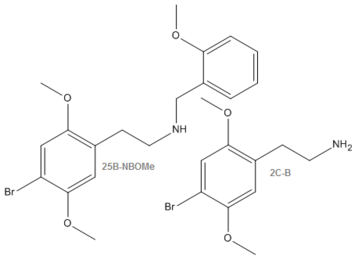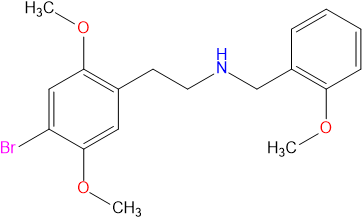25B-NBOMe
25B-NBOMe (2C-B-NBOMe) is a derivative of the substituted phenethylamine psychedelic 2C-B, discovered in 2004 by Ralf Heim at the Free University of Berlin. The chemical had no history of human use prior to being sold online as a designer drug.
Chemistry

25B-NBOMe is a substituted phenethylamine with methoxy groups attached to carbons R2 and R5 as well as a bromine attached to carbon R4. It differs from 2C-B structurally through a substitution on the amine (NH2) with a 2-methoxybenzyl (BOMe) group.
Pharmacology
25B-NBOMe has efficacy at the 5-HT2A receptor where it acts as a potent partial agonist.[1][2][3][4] However, the role of these interactions and how they result in the psychedelic experience continues to remain elusive.
Subjective effects
The effects listed below are based upon the subjective effects index and personal experiences of PsychonautWiki contributors. The listed effects will rarely if ever occur all at once but heavier dosages will increase the chances and are more likely to induce a full range of effects.
The physical effects of 25B-NBOMe can be broken down into six components all of which progressively intensify proportional to dosage. These are described below and generally include:
- Sublingual numbing - Assuming the substance has been taken sublingually, the very first physical effect which a person will notice immediately after sublingual absorption is a strong, unpleasant metallic chemical taste. This is accompanied by a very obvious feeling of general numbness of the tongue and mouth which can stay for up to an hour after the blotter paper has been consumed. This is the key difference when it comes to determining whether your blotter paper contains LSD or one of the NBOMe series.
- Spontaneous tactile sensations - The body high itself can be described as a generally mild, all-encompassing, soft but euphoric tingling sensation. This tingling sensation is also accompanied by spontaneous rushes of euphoria that become longer and more drawn out proportional to the dosage consumed.
- Decreased bodily weight - In terms of the body’s perceived weight, this substance consistently leaves people feeling extremely light, often to the point of total weightlessness.
- Stimulation - In terms of its effects on the physical energy levels of the tripper, 25B-NBOMe is usually considered to be energetic and stimulating, but it can be considered less stimulating when compared to 25I-NBOMe. For most people, this substance induces a unique type of physical stimulation which can be described as feeling extremely energetic but in a way which does not force the tripper to move unless they genuinely choose to do so. For others however, the stimulation can be quite uncontrollable, occasionally resulting in bodily shakes and a grinding of the teeth comparable to that of MDMA and traditional stimulants such as amphetamine, but this is manifested much less consistently when compared to 25I-NBOMe
- Nausea - As the tripper begins to come up, nausea is not uncommon and can sometimes result in initial vomiting, but passes once this has either happened or the trip begins to fully set in. In comparison to other psychedelics such as psilocin, LSD, 2C-E and 2C-I, this could actually be very considered very mild in its intensity.
- Vasoconstriction
The cognitive effects of 25B-NBOMe are described by many as remarkably light and underwhelming in comparison to more traditional psychedelics. It is not uncommon for people to report feeling that their thought stream has maintained general normality in its specific style throughout low to moderate dosages. At high dosages however, mild to overwhelming cognitive alterations become present.
The most prominent of these cognitive effects generally include:
- Increased empathy, love and sociability - The entactogenic effects range from mild to powerful, but are inconsistently manifested. entactogenic effects for people who try this substance usually become prominent in the presence of others. These feelings of increased sociability, love and empathy do not seem to be quite as strong or profound as those found within other entactogens (such as MDMA, 2C-B and AMT). They are however the most prominent entactogenic effects found within the Nbome series.
- Introspection - This component is consistently manifested only in the context of a non-social setting in which the user is alone.
- Acceleration of thought
- Time distortion
- Feelings of fascination, importance and awe
- Conceptual thinking
- Connectivity of thought
- Enhancement of current mind state
- Removal of cultural filter
- Ego suppression, loss and death
25B-NBOMe presents a full and complete array of possible visual enhancements which generally includes:
The visual distortions and alterations which are experienced are detailed below:
- Drifting (Melting, Flowing, Breathing and morphing) - In comparison to other psychedelics, this effect can be described as highly detailed, slow and smooth in motion, static in their appearance and unrealistic/cartoon-like in style.
- Tracers
- After images
- Texture repetition
- Colour shifting
- Scenery slicing
The visual geometry that is present throughout this trip is often described as similar in appearance to that of LSD. They can be comprehensively described as algorithmic in geometric style, intricate in complexity, fine and zoomed out in detail, fast and smooth in motion, structured in shape, colourful in scheme, glossy in colour, sharp around the edges and mostly rounded across their corners. In comparison to other more commonly used psychedelics they can be described as significantly more intricate than the visual geometry found within 2C-I and most of the 2C-x family in general as well as completely on par with LSD, Psilocin and DMT at appropriately high dosages.
In terms of their behaviour, 25B-NBOMe’s geometry leads onto Level 8A visual geometry with Level 8B remaining so far unconfirmed within this substance. They also seem to consistently build up in visual intensity when the tripper stares at a central point. This eventually envelops the visual field and creates the sensation that the tripper has broken through into a continuously shifting geometric landscape or structure with a vast sense of immersive physical size attributed to it.
25B-NBOMe is capable of producing a full range of hallucinatory states within the level 1 - 3 range extremely consistently. However, level 4 hallucinatory breakthroughs are reported but very uncommon and inconsistent in comparison to other more commonly used psychedelics such as psilocin, 2C-E and DMT.
These effects include:
- External hallucinations
- Internal hallucinations - this particular effect commonly contains hallucinations with scenarios, settings, concepts and autonomous entity contact. They are more common within dark environments and can be described as internal in their manifestation, lucid in believability, interactive in style and almost exclusively of religious, spiritual, mystical or a transcendental nature in their overall theme.
The auditory effects of 25B-NBOMe are common in their occurrence and exhibit a full range of effects which commonly includes:
Toxicity and Harm Potential
The toxicity and long term health effects of recreational 25B-NBOMe use do not seem to have been studied in any scientific context and the exact toxic dosage is unknown. This is because 25B-NBOMe is a research chemical with very little history of human usage. Anecdotal evidence from people who have tried 25B-NBOMe within the psychedelic community suggests that there are no negative health effects attributed to simply trying this drug at low to moderate doses or using it very sparingly (but nothing can be completely guaranteed). There is no current data for the LD50 of 25B-NBOMe, but it is thought to be high.
Tolerance and Addiction Potential
In terms of its addictive potential, 25B-NBOMe has not been studied formally but due to its immediate tolerance build up, which lasts up to 2 - 3 weeks after the experience, it is difficult to use this substance compulsively.
Legal Issues
- UK: 25B-NBOMe is under a temporary class drug order, lasting one year from 10th June 2013.[5]
- Sweden: 25b-NBOMe is classed as schedule I[6]
- USA On Nov 15, 2013, the DEA added 25B-NBOMe to Schedule I using their emergency scheduling powers, making it "temporarily" in Schedule I for 2 years. [7]
See Also
References
- ↑ Synthesis and pharmacology of potent 5-HT 2A receptor agonists with N-2-methoxybenzyl partial structure | http://www.diss.fu-berlin.de/diss/receive/FUDISS_thesis_000000001221
- ↑ Theoretical study of the interaction of agonists with the 5-HT2A receptor | http://epub.uni-regensburg.de/12119/
- ↑ Theoretical studies on the interaction of partial agonists with the 5-HT2A receptor | http://link.springer.com/article/10.1007%2Fs10822-010-9400-2
- ↑ Synthesis and Structure–Activity Relationships of N-Benzyl Phenethylamines as 5-HT2A/2C Agonists | http://pubs.acs.org/doi/abs/10.1021/cn400216u
- ↑ 'NBOMe' and 'Benzofury' banned | https://www.gov.uk/government/news/nbome-and-benzofury-to-be-banned/
- ↑ Läkemedelsverkets författningssamling - http://www.lakemedelsverket.se/upload/lvfs/LVFS_2013-15.pdf
- ↑ http://www.justice.gov/dea/divisions/hq/2013/hq111513.shtml
